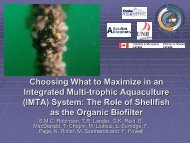Integrated multi-trophic aquaculture (IMTA) in marine temperate waters
Integrated multi-trophic aquaculture (IMTA) in marine temperate waters
Integrated multi-trophic aquaculture (IMTA) in marine temperate waters
You also want an ePaper? Increase the reach of your titles
YUMPU automatically turns print PDFs into web optimized ePapers that Google loves.
16<br />
<strong>Integrated</strong> mariculture – A global review<br />
support the establishment of <strong>IMTA</strong> systems <strong>in</strong> this region. Innovative kelp culture<br />
techniques have been developed and improved both <strong>in</strong> the laboratory and at the<br />
<strong>aquaculture</strong> sites. Increased growth rates of kelps (46 percent; Chop<strong>in</strong> et al., 2004) and<br />
mussels (50 percent; Lander et al., 2004) cultured <strong>in</strong> proximity to fish farms, compared<br />
to reference sites, reflect the <strong>in</strong>crease <strong>in</strong> food availability and energy. Nutrient,<br />
biomass and oxygen levels are be<strong>in</strong>g monitored to estimate the biomitigation potential<br />
of an <strong>IMTA</strong> site. Salmonid solid and soluble nutrient load<strong>in</strong>g is be<strong>in</strong>g modelled as<br />
the <strong>in</strong>itial step towards the development of an overall flexible <strong>IMTA</strong> model. The<br />
extrapolation of a mass balance approach us<strong>in</strong>g bioenergetics is be<strong>in</strong>g juxtaposed with<br />
modern measures of ecosystem health such as exergy. Over eight years, none of the<br />
therapeutants used <strong>in</strong> salmon <strong>aquaculture</strong> have been detected <strong>in</strong> kelps and mussels<br />
collected from the <strong>IMTA</strong> sites; levels of heavy metals, arsenic, PCBs and pesticides<br />
have always been below Canadian Food Inspection Agency, USA Food and Drug<br />
Adm<strong>in</strong>istration, and European Community Directive regulatory limits. A taste test at<br />
market size conducted on site grown versus reference mussels showed no discernable<br />
difference (Lander et al., 2004). Alexandrium fundyense, the d<strong>in</strong>oflagellate responsible<br />
for produc<strong>in</strong>g paralytic shellfish poison<strong>in</strong>g (PSP) tox<strong>in</strong>s, occurs annually <strong>in</strong> the Bay of<br />
Fundy and mussels can accumulate these tox<strong>in</strong>s above regulatory limits <strong>in</strong> the summer/<br />
early fall. However, PSP tox<strong>in</strong>s concentrations <strong>in</strong> mussels decreased readily as the<br />
blooms of Alexandrium fundyense dim<strong>in</strong>ished. Domoic acid, released by the diatom<br />
Pseudo-nitzschia pseudodelicatissima, was never above regulatory limits over the eight<br />
years. All of these results <strong>in</strong>dicate that, with the proper monitor<strong>in</strong>g and management,<br />
mussels and seaweeds from the <strong>IMTA</strong> operations can be safely harvested as seafood for<br />
human consumption (Haya et al., 2004).<br />
Two attitud<strong>in</strong>al studies towards salmon farm<strong>in</strong>g <strong>in</strong> general, and <strong>IMTA</strong> <strong>in</strong> particular,<br />
were conducted (Ridler et al., 2007). The first survey found that the general public is<br />
more negative towards current monoculture practices and feels positive that <strong>IMTA</strong><br />
would be successful (Rob<strong>in</strong>son et al., <strong>in</strong> press). The second attitud<strong>in</strong>al survey, a focus<br />
group study (Barr<strong>in</strong>gton et al., 2008), showed that most participants felt that <strong>IMTA</strong><br />
has the potential to reduce the environmental impacts of salmon farm<strong>in</strong>g (65 percent),<br />
improve waste management <strong>in</strong> <strong>aquaculture</strong> (100 percent), benefit community economies<br />
(96 percent) and employment opportunities (91 percent), and improve food production<br />
(100 percent), and the <strong>in</strong>dustry competitiveness (96 percent) and overall susta<strong>in</strong>ability<br />
(73 percent). All felt that seafood produced <strong>in</strong> <strong>IMTA</strong> systems would be safe to eat<br />
and 50 percent were will<strong>in</strong>g to pay 10 percent more for these products if labelled as<br />
such, which open the door to develop<strong>in</strong>g markets for differentiated premium <strong>IMTA</strong><br />
products, either environmentally labelled or organically certified.<br />
Prelim<strong>in</strong>ary data of a bio-economic model (Ridler et al., 2007), <strong>in</strong> which net present<br />
value (NPV) calculations are conducted over 10 years to portray long-term variability,<br />
show that the addition of seaweed and mussel to salmon farm<strong>in</strong>g is more profitable<br />
and helps reduce risks through diversification. The project is now scal<strong>in</strong>g up the<br />
experimental systems and work<strong>in</strong>g on an appropriate food safety regulatory and policy<br />
framework for the development of commercial scale <strong>IMTA</strong> operations with its two<br />
<strong>in</strong>dustrial partners, Cooke Aquaculture Inc. and Acadian Seaplants Limited. Presently,<br />
five amended salmon sites of Cooke Aquaculture Inc. are reach<strong>in</strong>g commercial scale<br />
development for both seaweeds and mussels.<br />
Site selection for the best compromise between site characteristics, species selection,<br />
and markets demands will be key to optimiz<strong>in</strong>g these <strong>IMTA</strong> operations. Further<br />
scal<strong>in</strong>g-up of cultivation systems (seaweed and mussel rafts), species diversification,<br />
economic analysis and development of niche markets will be implemented. Scal<strong>in</strong>g-up<br />
to commercial level will also allow the <strong>in</strong>vestigation <strong>in</strong>to the impacts of <strong>IMTA</strong> on the<br />
carry<strong>in</strong>g capacity of the coastal environment, water and benthos quality, potential for<br />
disease transfer, and animal and plant health at a realistically large scale to validate the



